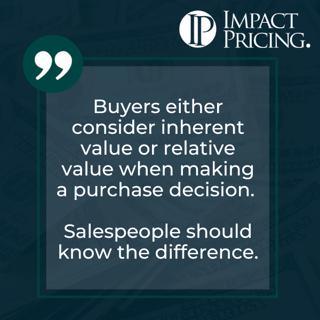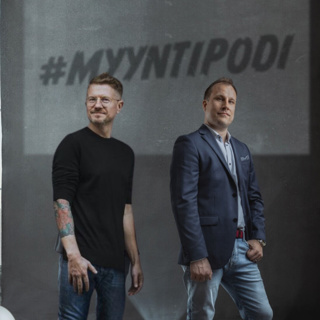
Listening to Your Market: The Key to Effective Pricing with Patrick Taylor
Patrick Taylor is a global business improvement expert with over 30 years of delivered value leveraging experience across all domains of pricing and margin improvement as well as commercial and financial processes. In this episode, Patrick shares the critical aspects of effective pricing strategies and their impact on business profitability. He emphasizes the importance of understanding both the external market and customer needs when setting prices. He also advocates for the use of various data visualization tools, such as scatterplots and Pareto charts, to analyze pricing effectiveness and identify areas for improvement. Why you have to check out today’s podcast: Gain insights into customer-focused pricing and understand market conditions when setting prices to align pricing strategies with customer expectations. Learn about profitability metrics and delve into the significance of monitoring profitability by customer and product. Understand sales team dynamics to empower sales teams with the knowledge and tools needed to confidently sell at set prices. "Listen to your customers, look at your market, look externally first on price." - Patrick Taylor Topics Covered: 01:14 - Patrick describing his journey into the pricing world 04:01 - Sharing his insights on how pricing has evolved over the years and his fundamental approach to it 07:22 - Emphasizing on the importance of focusing on customer value rather than getting overly caught up in tools like Excel or AI 08:54 - How to motivate executives to focus more on the value they deliver to customers and the decisions those customers have to make 11:58 - Aligning product offerings with customer needs and maximizing revenue opportunities 13:38 - How convincing a CEO to focus on pricing requires demonstrating that there is a real problem 17:34 - Highlighting the importance of using data-driven KPIs and charts to understand pricing behavior and sales performance and important thoughts about price variance 22:09 - What is it about the Pareto chart that he considers it when doing pricing 26:24 - Discussing the importance of focusing on margin dollars over margin percentages, especially when market conditions dictate pricing 29:14 - Patrick's best pricing advice Key Takeaways: "At the end of the day, from a pricing perspective, the customer only cares about two things. They care about the value they get relative to what they're buying and relative to the next best competitive alternative." - Patrick Taylor "Putting that customer first is the number one thing you've got to do." - Patrick Taylor "You can create the best model in the world, but if it doesn't work easily for your sales team to work, they can't communicate it to their customer; it's a problem." - Patrick Taylor People/Resources Mentioned: Tom Nagle: https://impactpricing.com/podcast/604-insights-into-value-based-pricing-strategies-for-b2b-with-tom-nagle/ Alteryx: https://www.alteryx.com Google: https://www.google.com/?client=safari Tableau: https://www.tableau.com Pros: https://pros.com Connect with Patrick Taylor: LinkedIn: https://www.linkedin.com/in/patrickjtaylor/ Connect with Mark Stiving: LinkedIn: https://www.linkedin.com/in/stiving/ Email: mark@impactpricing.com
2 Syys 202431min

Mastering the Nine Boxes: A Strategic Approach to Pricing with David Brown
David Brown is the author of "Banned Business Books, Volume 1, Pricing," a fictional account that narrates how a marketer and a pricing guru stand up and optimize the pricing function in a company. In this episode, David shares what his book 'Banned Business Books' is all about highlighting the "Nine Boxes" framework for organizing and executing pricing strategies effectively. He emphasizes the critical role of a Pricing Council in bringing order and clarity to pricing decisions within a company. Additionally, he highlights the value of understanding customers deeply and segmenting them to optimize pricing and business outcomes. Why you have to check out today’s podcast: Deep dive into the nine boxes framework, a comprehensive tool for organizing and executing pricing strategies. Learn the critical importance of understanding your customers as the foundation for effective pricing. Discover how to set up a pricing council and navigate the challenges of pricing in different organizations. "Don't start thinking that you're going to figure out pricing by looking at margins; start with the customers." - David Brown Topics Covered: 01:34 - Sharing his pricing journey 03:31 - Discussing the role of finance professionals in relation to pricing and how their focus is on defending and improving margins 06:22 - What made him title his book as Banned Business Books 08:51 - Addressing a critique from Mark about the applicability of his book's content 10:26 - Elaborating on the origin and development of his "nine boxes" framework for pricing 14:09 - Discussing how different aspects of pricing, such as packaging and portfolio optimization fit within his "nine boxes" framework 16:02 - How he continues to use the "nine boxes" as a way to organize and prioritize pricing projects, especially when collaborating with a pricing council 18:07 - Sharing his insights on establishing and maintaining an effective pricing council 20:08 - Agreeing that pricing is a critical function and is often a new and somewhat undefined role 21:04 - Proposing the idea of a pricing council to a CEO 23:08 - David's best pricing advice 25:29 - What the Volume 2 of his book series will focus on Key Takeaways: "Price setting is critical; that's where you have the opportunity to start claiming the value that you deserve for your innovations." - David Brown "The main thing that the Pricing Council has to have is energy and a purpose; the ones that do the best have a clear mandate, meaning that the decisions that the council takes on price are carried out and are effective across the company." - David Brown "You want to speak with the leaders and the potential figures that are going to be in the pricing council first and understand what makes the company tick and what needs to be fixed before you start fixing things." - David Brown People/Resources Mentioned: Unilever: https://www.unilever.com.ph Mosaic: https://www.mosaic.com/sustainability American Express: https://www.americanexpress.com Netflix: https://www.netflix.com/ph-en/ Blackberry: https://www.blackberry.com/us/en Connect with David Brown: LinkedIn: https://www.linkedin.com/in/dbrown14/ Website: www.bannedbusinessbooks.com Connect with Mark Stiving: LinkedIn: https://www.linkedin.com/in/stiving/ Email: mark@impactpricing.com
26 Elo 202426min

Blogcast: Understanding Fencing: Google’s Strategy to Maintain Regional Pricing for YouTube Premium
This is an Impact Pricing Blog published on July 4, 2024, turned into an audio podcast so you can listen on the go. Read Full Article Here: https://impactpricing.com/blog/understanding-fencing-googles-strategy-to-maintain-regional-pricing-for-youtube-premium/ If you have any feedback, definitely send it. You can reach us at mark@impactpricing.com. Now, go make an impact. Connect with Mark Stiving: Email: mark@impactpricing.com LinkedIn: https://www.linkedin.com/in/stiving/
23 Elo 20243min

How Behavioral Economics Influence Consumer Decisions Effectively with Kristen Berman
Kristen Berman co-founded Irrational Labs, a behavioral product design company, with Dan Ariely in 2013. Irrational Labs helps companies and nonprofits understand and leverage behavioral economics to increase the health, wealth and happiness of their users. In this episode, Kristen explores the intricacies of pricing strategies, emphasizing the importance of understanding behavioral economics to influence consumer decisions effectively. She discusses how techniques like the decoy effect, anchoring, and the power of price endings (like 99 cents) can drive customer behavior. Additionally, she highlights the challenges of pricing revolutionary products due to the lack of reference points and the creative approaches needed to establish them in the market. Why you have to check out today’s podcast: Deep dive into pricing strategies like the Good-Better-Best model, the Decoy Effect, and the psychology behind price ending to help you understand how to make pricing decisions that drive customer behaviors and increase sales. Find out valuable perspectives on how human psychology influences purchasing decisions which is essential for anyone looking to optimize their pricing or marketing strategies. Discover practical advice and real-world examples to see how you can apply these concepts to your own business. "It's all relative. So, what are customers using as a reference point? If it's off your product site, then you need to help them create a new reference point within your product site." - Kristen Berman Topics Covered: 01:14 - Sharing how she transitioned into behavioral economics from her role as a product manager at Intuit 03:42 - How behavioral science tie to pricing and product 06:10 - An example of how behavioral economics influence product decisions 08:50 - Explaining the concept of the "paradox of choice" 11:35 - Turning the path of least resistance into the preferred choice 14:30 - Simplifying decision-making for customers with the concept of "good, better, best" product offerings 16:42 - Explaining the decoy effect and how it influences consumer decision-making 19:09 - The reason behind the presentation of pricing options in the context of behavioral economics 22:43 - The concept of framing in sales in the context of product features and the importance of trials in subscription-based models 25:25 - How people often rely on heuristics, or mental shortcuts, when making decisions about prices 28:56 - Kristen's best pricing advice 29:28 - Various sources of reference points 31:19 - The challenge of pricing revolutionary products due to the lack of existing reference points Key Takeaways: "People don't come in with an understanding of the exact thing that they want to purchase at the exact moment. And so, our job is to help them understand value, and choice helps people understand value." - Kristen Berman "We're using the heuristics on how big the number is to make a lot of fairness decisions." - Kristen Berman "We are relative creatures. We have reference points and we use our reference points to understand value. And so, it's not just the price, it's the reference point that we're using." - Kristen Berman People/Resources Mentioned: Intuit: https://quickbooks.intuit.com/ TikTok: https://www.tiktok.com Airbnb: https://www.airbnb.com Dan Ariely: https://danariely.com/all-about-dan/ One Medical: https://www.onemedical.com Steve Jobs: https://en.wikipedia.org/wiki/Steve_Jobs Apple: https://www.apple.com/ YouTube: https://www.youtube.com Netflix: https://www.netflix.com/ Study: https://play.google.com/store/apps/details?id=com.thesoundagency.study&hl=en_ZA&pli=1Shopify: https://www.shopify.com/ph Connect with Kristen Berman: LinkedIn: https://www.linkedin.com/in/kristenberman/ Connect with Mark Stiving: LinkedIn: https://www.linkedin.com/in/stiving/ Email: mark@impactpricing.com
19 Elo 202432min

Blogcast: How to Charge Different Customers Based on Value Received
This is an Impact Pricing Blog published on June 27, 2024, turned into an audio podcast so you can listen on the go. Read Full Article Here: https://impactpricing.com/blog/how-to-charge-different-customers-based-on-value-received/ If you have any feedback, definitely send it. You can reach us at mark@impactpricing.com. Now, go make an impact. Connect with Mark Stiving: Email: mark@impactpricing.com LinkedIn: https://www.linkedin.com/in/stiving/
16 Elo 20243min

#CLASSIC The Power of Behavioral Economics in Pricing with Florian Bauer
Florian Bauer is an internationally sought-after expert and speaker on the subject of price psychology and behavioral pricing. He is an honorary professor at the Technical University of Munich and author of several books on price research. He also has a doctorate in Psychology at TU Darmstadt, MIT, and Harvard. In this episode, Florian talks about how discounts can give you short-term gain but cost you long-term. He underscores that there are other means to incentivize customers without diminishing a products’ value perception. And that cashback is one thing to consider other than discounts. He also talks about buyers’ irrationalities and how to use Behavioral Economics to influence their decision-making and let it work in your favor. Why you have to check out today’s podcast: Learn about the psychology of price structure and how it influences consumers’ buying behavior Find out what you can, what you should, and what you should not do when giving a discount Learn how Behavioral Economics can help you influence buyers’ decision-making and maximize your company’s profit “If you want to price or sell something, you have to think in two dimensions. You have to think about what people want. That's the traditional value-based approach. And you have to think in the dimension of how they decide.” - Florian Bauer Topics Covered: 01:28 - How Florian got started in Pricing 02:25 - What the psychology of price structure is all about 03:22 - What a price structure looks like 04:12 - What’s the psychology behind using cashback than just lowering the price 06:03 - How do discounts differ from cashback 07:39 - The feeling of disconnect with cashback 08:20 - Cashback being an icing on the cake that can potentially make you feel more decided about your choice 10:02 - What’s the disadvantage of discounting 11:36 - What behavioral economics means for pricing 16:15 - Different people behave differently when it comes to decision irrationalities 18:00 - His thoughts on the ethical issue about Behavioral Economics 23:22 - What is Behavioral Economics showing us and why this works in the B2B world 25:38 - How heuristics simplify complex decisions 29:35 - Florian’s best pricing advice that can significantly impact your business Key Takeaways: “Never ever give a discount without anything the customer has to give in return.” - Florian Bauer “That's the issue with discounting. It really works very well short-term. So, you have to gain short term, but you have to cost long-term.” - Florian Bauer “If I want to sell somebody something, I need to know what he wants, or she wants, and I need to adapt my sales approach and my pricing model, potentially, to how he decides.” - Florian Bauer “For me, the purpose of marketing, pricing, and sales is to influence decisions. So, there is no reason to have a marketing campaign or a marketing team if you would not have the idea that I can influence my customers' decision in my favor.” - Florian Bauer “I think when we talk about value and price acceptance, it's very much a story. And there is not one story better than another one. People hate to make decisions, they want to be made decided and with some stories, they are quicker in deciding than in others.” - Florian Bauer “Think about that you're not only selling value; you’re also managing decisions. If you keep that in mind when you design your pricing model, you also avoid the traditional clash between pricing and sales because you're also able to tell your salespeople how they can actually execute your pricing strategy to make the customers actually follow the decision or the directions you want them to.” - Florian Bauer Resources / People Mentioned: Daniel Kahneman: https://en.wikipedia.org/wiki/Daniel_Kahneman Connect with Florian Bauer: Email: florian.bauer@vocatus.de LinkedIn: https://www.linkedin.com/in/profdrflorianbauer/ Connect with Mark Stiving: Email: mark@impactpricing.com LinkedIn: https://www.linkedin.com/in/stiving/
12 Elo 202431min

Blogcast: Revamp Your Pricing Strategy: Pros & Cons of 4 Popular Models
This is an Impact Pricing Blog published on June 20, 2024, turned into an audio podcast so you can listen on the go. Read Full Article Here: https://impactpricing.com/blog/revamp-your-pricing-strategy-pros-cons-of-4-popular-models/ If you have any feedback, definitely send it. You can reach us at mark@impactpricing.com. Now, go make an impact. Connect with Mark Stiving: Email: mark@impactpricing.com LinkedIn: https://www.linkedin.com/in/stiving/
9 Elo 202410min

Generative Pricing Explained: How AI Will Transform Value Measurement and Proposal Success with Steven Forth
Steven Forth is Ibbaka’s Co-Founder, CEO, and Partner. Ibbaka is a strategic pricing advisory firm. He was CEO of LeveragePoint Innovations Inc., a SaaS business. In this episode, Steven explores the concept of generative pricing, emphasizing how AI can transform pricing strategies through real-time value measurement and dynamic proposal evaluation. He discusses how composable AI applications and generative adversarial networks might drive advancements in pricing and proposal management. Practical advice is also provided on using AI to optimize proposals, including developing effective evaluation rubrics and leveraging AI for better decision-making. Why you have to check out today’s podcast: Delves into the concept of generative pricing and how it can revolutionize pricing strategies through real-time value measurement, composability, and AI-driven proposal evaluation. Discover actionable advice on using AI to evaluate and improve proposals before submission which includes tips on developing effective rubrics and using AI tools to enhance proposal quality. Explore the future of pricing in a world increasingly influenced by AI, including the challenges of scaling costs, measuring value, and managing pricing with AI. "Build a system that will evaluate your proposals, including your pricing proposals, before you send them out. You can do this using your currently available AI tools." - Steven Forth Topics Covered: 01:01 - Introducing the concept of "generative pricing" in the context of generative AI applications 02:17 - Elaborating on the concept of generative pricing by discussing the cost dynamics associated with generative AI applications compared to traditional SaaS applications 04:35 - Discussing the differences in cost between traditional search engines like Google and AI-powered services like Perplexity, highlighting the implications for generative pricing 09:28 - Shift in cost structures and the emerging properties of generative AI applications 13:54 - Configuring solutions that optimize the value delivered to customers continuously 16:02 - The potential for generative AI to enable more accurate and transparent value-based pricing models 18:41 - Explore the concept of generative pricing in the context of proposals and outcome-based pricing 22:10 - The idea of making predictions about the future of pricing, particularly in the context of generative AI, using a website called longbets.com 23:01 - How generative pricing necessitates a rethinking of pricing approaches 24:01 - Generative AI and how it affects cost management and value capture 25:30 - Discussing the implications of generative AI on the value and pricing of applications, particularly focusing on composable AI 28:42 - Steven's best pricing advice and actionable steps for leveraging AI in proposal evaluation and improvement Key Takeaways: "Yes, we have to be aware of costs. And the pricing systems are also going to need to be cost-management systems. But what's going to drive the configuration is value optimization." - Steven Forth "Is generative pricing a clear, fully baked concept today? No, it's not. But I believe that generative AI is going to cause enough change that it's going to force us to rethink how we approach pricing." - Steven Forth "...possibly as we get more sophisticated and flexible models, we'll be able to more formally manage the relationship between emotional values and also do a better job of pricing in order to reflect externalities." - Steven Forth "We're going to have to really start designing our proposals and our pricing with the assumption that the consumer or one of the consumers is actually going to be an AI. And I think that also changes how we think about the pricing as well, and we're gonna need AIs in order to generate pricing that other AIs are going to accept." - Steven Forth People/Resources Mentioned: Intercom: https://www.intercom.com Perplexity: https://www.perplexity.ai Google: https://www.google.com/?client=safari Gemini: https://gemini.google.comTheory Theory Ventures: https://theory.ventures Oracle: https://www.oracle.com Microsoft: https://www.microsoft.com/en-ph/ Totogi: https://totogi.com Long Bets: https://longbets.org Connect with Steven Forth: LinkedIn: https://www.linkedin.com/in/stevenforth/ Email: steven@ibbaka.com Connect with Mark Stiving: LinkedIn: https://www.linkedin.com/in/stiving/ Email: mark@impactpricing.com
5 Elo 202431min






















